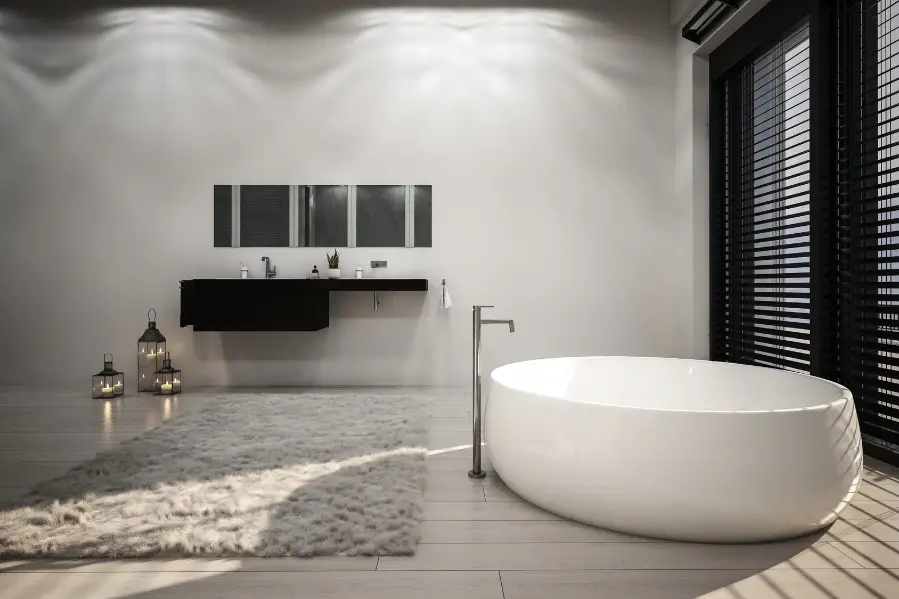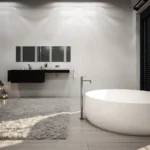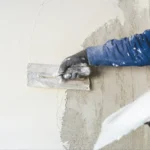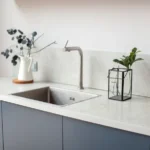As the focal point of your bathroom, a freestanding soaking bathtub has the ability to transform the area. Choosing a freestanding bathtub goes far beyond appearances to become a process of creating your private escape in the convenience of your own home. It all comes down to selecting a focal point that expresses your unique aesthetic, the individuality of your bathroom, and how you calm.
Choosing the right style and content may make a smooth transition between a shape and function that suits your interests and style. If you are aware of your needs and the readily available alternatives, choosing the ideal tub design for your new bathing retreat will be easy.
In this article, you will discover everything you need to know about freestanding soaking bathtubs, including crucial factors to consider. Now, let’s get started!
Freestanding Soaking Tubs: What Are They?
Freestanding soaking tubs are a popular choice for modern bathrooms, offering both visual appeal and practical benefits. Unlike traditional bathtubs mounted to a wall, freestanding tubs stand alone and can be viewed from all sides, making them a focal point in any bathroom.
A key advantage of a freestanding soaking tub is its flexibility in placement. Without being attached to a wall, it can be positioned in various locations—near a window, in a corner, or at the center of the room—to suit the layout and design of the space.
Freestanding tubs come in different shapes, sizes, and materials to fit various styles. Options range from minimalist models to vintage clawfoot tubs. Common materials include lightweight acrylic, durable cast iron with good heat retention, and stone or resin for a high-end look.
These tubs provide a deep soaking experience, allowing bathers to fully submerge and relax, which can help reduce stress and soothe muscles. Freestanding tubs create a spa-like feel, enhancing the bathing experience at home.
Types and Styles of Soaking Bathtubs
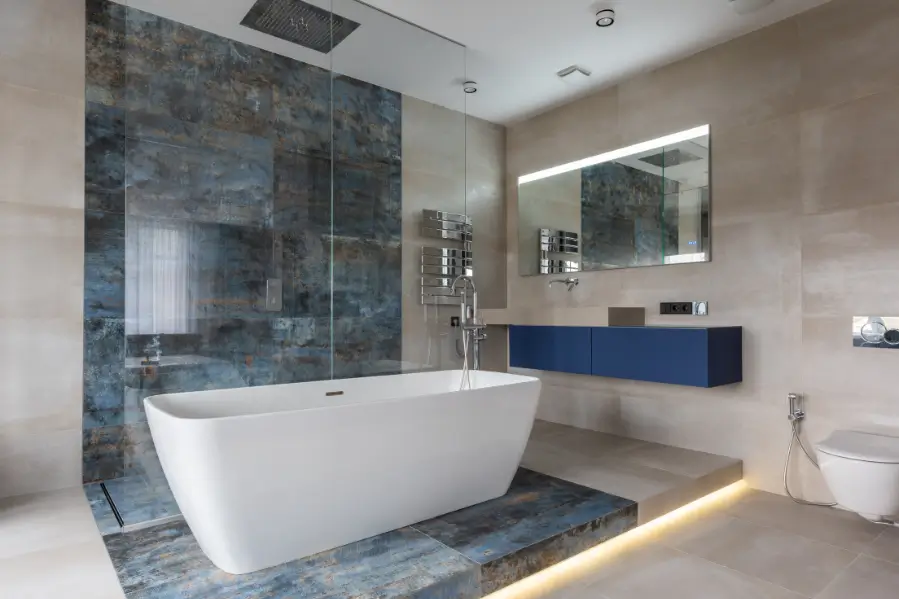
In addition to being attractive to look at, soaking baths have numerous uses. They are available in a variety of sizes and styles, such as clawfoot, pedestal, single and double-ended, as well as slipper.
1. Clawfoot Bathtubs
This design has been popular since the turn of the nineteenth century and is still a popular option for those who are interested in modernizing their bathrooms while keeping a more classic look. The tub is elevated above the ground by four “feet” that are set at its corners. As a matter of fact, the clawfoot tub was considered as furniture in the 19.
2. Single and Double Slipper Bathtubs
Both single and double slippers have one or both ends elevated, giving them a slipper-like aspect. Single-slipper soak tubs have an elevated position on the side opposing the drain to allow the user to relax and lie back without the drain getting in the way. Some tubs have both ends elevated and a double slipper to allow for relaxation on both sides or for multiple bathers to use.
3. Pedestal Bathtubs
Similar to clawfoot tubs, pedestal tubs will be elevated above the ground, but they will do so on a pedestal rather than on feet. In addition to creating the perception that the soaking tub is on the ground, this more evenly distributes the tub’s weight.
4. Double-ended and Single-ended Bathtubs
Single-ended as well as double-ended tubs will stick out at an angle to allow for comfortable soaking, much similar to the slipper tubs. Whereas double-ended tubs extend on both sides for dynamic relaxation, single-ended tubs extend on the side opposing the drain for accessible seating.
Factors to Consider While Buying a Freestanding Soaking Tub
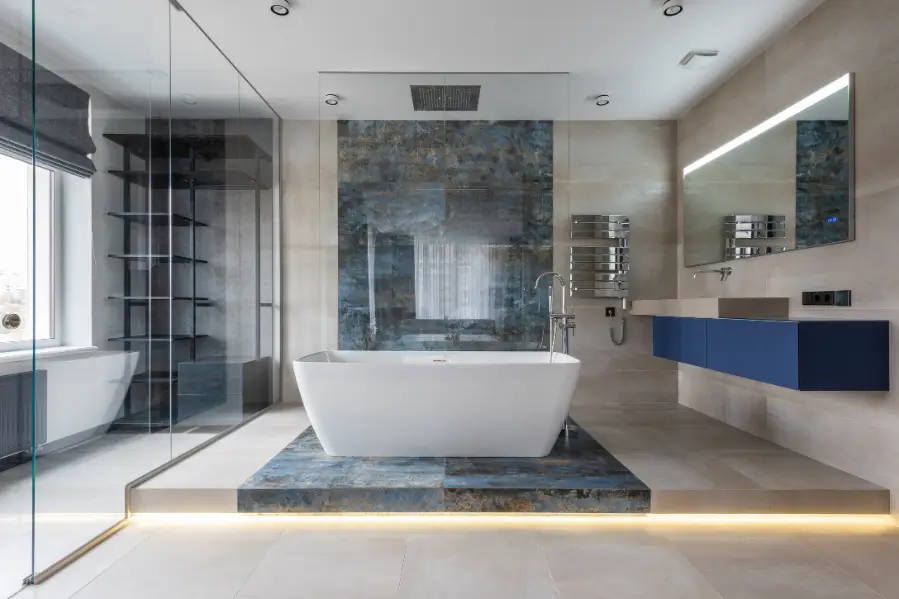
Your bathroom might become a beautiful getaway if you decide to buy a freestanding soaking bathtub. However, choosing and setting up the ideal tub calls for thoughtful consideration. Let’s examine the essential elements to take into account before making a purchase:
1. Requirements and Financial Plan
Start by outlining what you need as well as your spending limit. Take into account the tub’s dimensions, shape, and desired soaking depth. Which style do you like better, an old-fashioned oval, a modern rectangle, or maybe a unique slipper tub? It all depends on your own choice. The dimensions and style you can allow will also depend on the amount of room in your bathroom.
Additionally, the tub’s material is essential. Although cast iron is heavy and expensive, it is durable and has good heat retention. Acrylic is an extremely common material since it is inexpensive, lightweight, and comes in a wide range of colors and designs. Stone resin offers a contemporary appeal while maintaining the right balance between weight and sturdiness.
What you can choose in terms of features and materials will ultimately depend on how much you can afford.
2. Material Considerations
Cast iron bathtubs are widely recognized for their lifespan and water temperature maintenance capabilities. However, because of their weight, they must be handled carefully during the setup, and the floor might need to be reinforced.
Acrylic bathtubs come in various styles and shades and are an economical choice. Despite being lighter than cast iron, they may need to improve at maintaining heat. The weight and longevity of stone resin tubs are equally balanced.
They provide a modern appearance and require very little maintenance, although they are generally higher in price than acrylic.
3. Room and Set up
Take precise measurements of your bathroom, including the doors and hallways, before making a bathtub purchase. Make sure the bathtub you select can be moved about and set up in your room with ease. Take into account the tub’s height and how effortless it is to get in and out.
The installation method can be particularly challenging when it comes to heavy materials such as cast iron. You might have to install new plumbing fittings or move your current ones.
Strengthening the floor may be required in certain situations that can withstand the load of the tub. It is strongly advised to use a professional plumber to ensure the proper setup and prevent any possible leaks or destruction.
4. Other Things to Think About
Think about the tap and other accessories in addition to the bathtub itself. Make sure the tap you choose gives the functionality you want and integrates with the overall layout of your bathtub.
Make sure that the water flow and drain capacity are adequate to avoid overflow and delayed draining. Also, consider the bathtub’s aesthetics and how nicely it fits in with the overall aesthetic of your bathroom.
The amount of care needed varies depending on the material. In some cases, more occasional cleaning and polishing may be required. Give your full attention to safety components such as grab handles and non-slip surfaces, particularly if you struggle with movement issues.
5. Purchasing and Comparison
Examine local and internet retailers to figure out pricing and alternatives. While local businesses allow you to examine things in person and receive guidance from experts, online stores provide a more significant collection and less expensive prices. Before making an investment, remember to read feedback from others and compare the cost.
Price Range: What is the cost of freestanding soaking tubs?
Freestanding bathtubs are available in various price ranges to suit different preferences and budgets. Entry-level freestanding tubs typically start at around $800 to $1,500. These are often made from materials like acrylic or fiberglass, which are lightweight and affordable.
Mid-range options, priced between $1,500 and $4,000, may include higher-quality acrylic, cast iron, or stone resin. These tubs often offer better durability, heat retention, and more design choices.
High-end freestanding soaking tubs can range from $4,000 to $10,000 or more. These premium models are often custom-built or made from luxury materials such as natural stone or copper, featuring unique designs and advanced features like whirlpool jets or integrated heating elements.
When calculating the price of a freestanding soaking tub, it’s essential to consider variables such as the material, dimensions, and features.
Service Recommendation: Expert Bathroom Remodeling in Houston, Texas
For a seamless bathroom transformation, Smart Remodeling LLC in Houston, Texas, offers expert remodeling services tailored to your style and space. We handle every aspect—from tub installation to plumbing and electrical adjustments—ensuring high-quality results.
With custom layouts, premium material options, and energy-efficient solutions, Smart Remodeling LLC creates a luxurious, spa-like retreat right in your home.
The bottom line
Freestanding bathtubs are a stylish addition to almost any bathroom and provide an effective way of relaxing at the end of the Day. Additionally, there are many alternatives for these tubs, so you’re sure that you can find one that meets your needs and your bathroom.
Taking these aspects into account when selecting and installing the ideal freestanding soaking tub can transform your bathroom into a luxurious getaway. To preserve the beauty of your new bathtub for many years to come, make sure you follow the manufacturer’s recommended care directions while relaxing and enjoying it.

